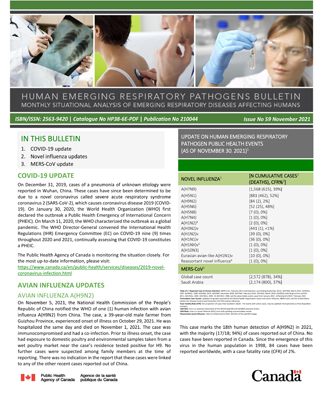Human emerging respiratory pathogens bulletin: Issue 59, November 2021
Download in PDF format
(1.1 MB, 3 pages)
Organization: Public Health Agency of Canada
Date published: 2021-12-14
Monthly situational analysis of emerging respiratory diseases affecting humans (data to November 30, 2021)
In this bulletin
- COVID-2019 update
- Avian influenza updates
- Swine influenza updates
- Middle East respiratory syndrome coronavirus (MERS-CoV) update
| Novel influenzaTable 1 Footnote 1 | Cumulative Case CountTable 1 Footnote 2 | Deaths | Case Fatality Rate %Table 1 Footnote 3 |
|---|---|---|---|
| A(H7N9) | 1,568 | 615 | 39% |
| A(H5N1) | 881 | 462 | 52% |
| A(H9N2) | 84 | 2 | 2% |
| A(H5N6) | 52 | 25 | 48% |
| A(H5N8) | 7 | 0 | 0% |
| A(H7N4) | 1 | 0 | 0% |
| A(H1N2)Table 1 Footnote 4 | 2 | 0 | 0% |
| A(H3N2)v | 441 | 1 | <1% |
| A(H1N2)v | 39 | 0 | 0% |
| A(H1N1)v | 36 | 0 | 0% |
| A(H1NX)vTable 1 Footnote 5 | 1 | 0 | 0% |
| A(H10N3) | 1 | 0 | 0% |
| Eurasian avian-like A(H1N1) | 10 | 0 | 0% |
| Reassortant novel influenzaTable 1 Footnote 6 | 1 | 0 | 0% |
| MERS-CoVTable 1 Footnote 1 | Cumulative Case CountTable 1 Footnote 2 | Deaths | Case Fatality Rate %Table 1 Footnote 3 |
| Global Case Count | 2,572 | 878 | 34% |
| Saudi Arabia | 2,174 | 800 | 37% |
|
|||
COVID-19 update
On December 31, 2019, cases of a pneumonia of unknown etiology were reported in Wuhan, China. These cases have since been determined to be due to a novel coronavirus called severe acute respiratory syndrome coronavirus 2 (SARS-CoV-2), which causes coronavirus disease 2019 (COVID-19). On January 30, 2020, the World Health Organization (WHO) first declared the outbreak a Public Health Emergency of International Concern (PHEIC). On March 11, 2020, the WHO characterized the outbreak as a global pandemic. The WHO Director-General convened the International Health Regulations (IHR) Emergency Committee (EC) on COVID-19 nine (9) times throughout 2020 and 2021, continually assessing that COVID-19 constitutes a PHEIC.
The Public Health Agency of Canada is monitoring the situation closely.
Avian influenza updates
Avian influenza A(H9N2)
On November 5, 2021, the National Health Commission of the People's Republic of China notified the WHO of one (1) human infection with avian influenza A(H9N2) from China. The case, a 39-year-old male farmer from Guizhou Province, experienced onset of illness on October 29, 2021. He was hospitalized the same day and died on November 1, 2021. The case was immunocompromised and had a co-infection. Prior to illness onset, the case had exposure to domestic poultry and environmental samples taken from a wet poultry market near the case's residence tested positive for H9. No further cases were suspected among family members at the time of reporting. There was no indication in the report that these cases were linked to any of the other recent cases reported out of China.This case marks the 18th human detection of A(H9N2) in 2021, with the majority (17/18; 94%) of cases reported out of China. No cases have been reported in Canada. Since the emergence of this virus in the human population in 1998, 84 cases have been reported worldwide, with a case fatality rate (CFR) of 2%.
Avian influenza A(H5N6)
Zero (0) human cases of avian influenza A(H5N6) were reported in November 2021.
To date in 2021, 26 cases of avian influenza A(H5N6) have been reported globally (Figure 2); 25 A(H5N6) cases were reported from China and one (1) case was reported from Lao PDR. The 25 cases from China were reported from seven (7) different regions (Figure 3): Guizhou Province, Anhui Province, Guangxi Zhuang Autonomous Region, Sichuan Province, Hunan Province, Guangdong Province, and Chongqing Municipality. The median age of the cases reported in 2021 was 53.5 years (age range: 1-72 years) and 50% (13/26) of these cases were male. At least seven (7) cases reported this year died (Footnote *CFR: 24%); however, most cases were in critical condition at the time of report. None of these cases were known to be connected to each other, or to previously reported cases, other than one couple (husband and wife) who shared a common exposure source (slaughtered and cooked duck). There is no evidence of human-to-human transmission of the virus.
A total of 52 laboratory-confirmed human cases of avian influenza A(H5N6), including at least 25 deaths (Footnote *CFR: 48%) have been reported globally since 2014. No cases have been reported in Canadian residents.
Swine influenza updates
Swine origin influenza A(H1N2)v
In November 2021, two (2) new human cases of A(H1N2)v were detected, one (1) from the United States (US) and one (1) from Canada.
The US CDC reported one (1) new A(H1N2)v case in Indiana from the 2020-2021 influenza season. The case, ≥18 years of age, was not hospitalized and has recovered from their illness. The case had attended an agricultural event and/or farm where swine were present. No ongoing human-to-human transmission was identified in association with this case.
The A(H1N2)v case in Canada was detected in Manitoba. The case, ≥18 years of age, was exposed to swine through the workplace prior to illness onset. The case developed non-severe symptoms and has since recovered. There were no detections of illness among close household and workplace contacts of the case.
Including the case reported in November 2021, three (3) A(H1N2)v detections have been reported in Canadian residents since reporting began in 2005. A total of 39 cases have been reported globally since 2005, with a 0% case fatality rate. There have been 11 A(H1N2)v cases reported globally in 2021.
Swine origin influenza A(H3N2)v
The most recent case of swine origin influenza A(H3N2)v was reported in October 2021 from the US.
Two A(H3N2)v detections have been reported in Canadian residents since reporting began in 2005, with the latest case reported in June 2021. Globally, 441 A(H3N2)v cases have been reported since 2005, with <1% case fatality rate. There have been 5 A(H3N2)v cases reported worldwide in 2021.
Swine origin influenza A(H1N1)v
In November 2021, the US CDC reported two (2) new human cases of swine origin influenza A(H1N1)v in Iowa that had occurred in the 2020-2021 season. The cases, ≥18 years of age, were not hospitalized, and had both recovered. The cases had attended an agricultural event and/or farm where swine were present. No ongoing human-to-human transmission was identified in association with these cases.
Two A(H1N1)v detections have been reported in Canadian residents since reporting began in 2005, with the latest case reported in April 2021. Globally, 36 human cases of A(H1N1)v have been reported since 2005, with no associated fatalities. There have been seven (7) A(H1N1)v cases reported worldwide in 2021.
Swine origin influenza A(H1NX)v
In November 2021, one human infection with a novel influenza A(H1, neuraminidase results pending) [A(H1NX)v] was reported by the US in Oklahoma. The case, ≥18 years of age, was hospitalized for an unrelated illness and has since been discharged. The case reported contact with swine at home and at an agricultural event prior to specimen collection. No ongoing human-to-human transmission was identified in association with this case.
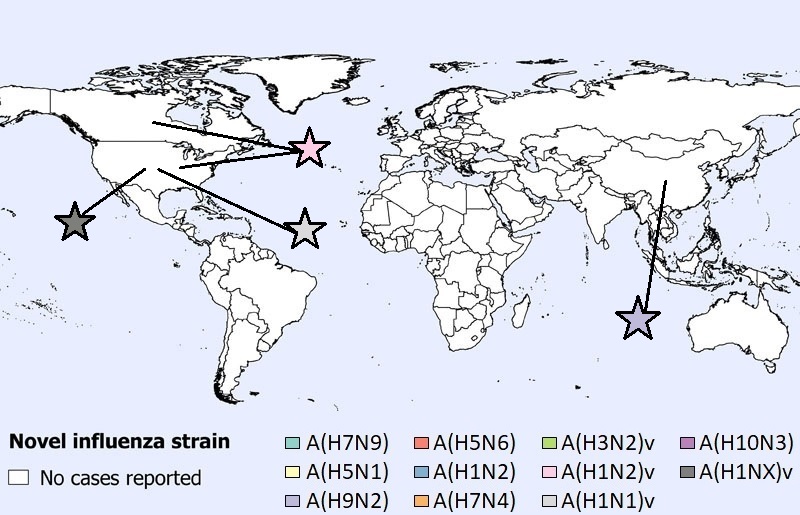
Note: Map was prepared by the Centre for Immunization and Respiratory Infectious Diseases (CIRID) using data from the latest WHO Event Information Site (EIS) postings and Weekly US Influenza Surveillance Reports (FluView). This map reflects data available through these publications as of November 30, 2021.
Figure 1 - Text equivalent
- One A(H9N2) case was reported in China.
- Two A(H1N1)v cases were reported in the United States of America.
- One A(H1N2)v case was reported in the United States of America.
- One A(H1N2)v case was reported in Canada.
- One A(H1NX)v case was reported in the United States of America.
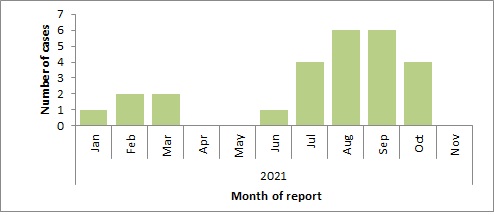
Note: Graph was prepared by the Centre for Immunization and Respiratory Infectious Diseases (CIRID) using data from the WHO EIS postings and the Hong Kong Centre for Health Protection (CHP) press releases. This graph reflects data available as of November 30, 2021.
Figure 2 - Text equivalent
| Month | Cases |
|---|---|
| Jan | 1 |
| Feb | 2 |
| Mar | 2 |
| Apr | 0 |
| May | 0 |
| June | 1 |
| July | 4 |
| Aug | 6 |
| Sep | 6 |
| Oct | 4 |
| Nov | 0 |
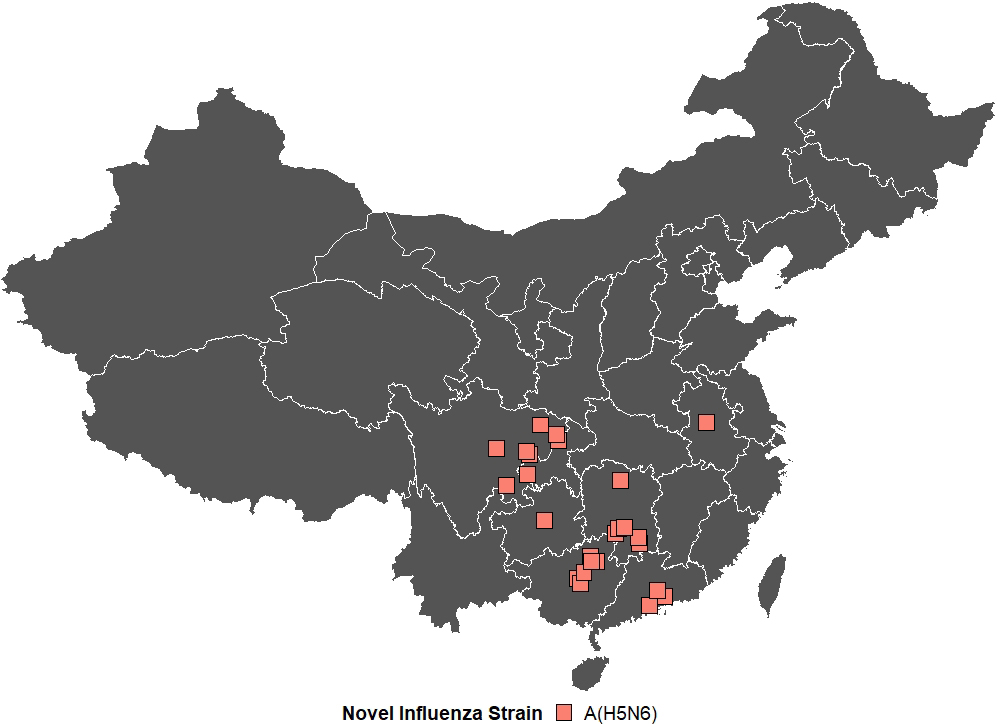
Note: Map was prepared by the Centre for Immunization and Respiratory Infectious Diseases (CIRID) using data from the WHO EIS postings and the Hong Kong Centre for Health Protection (CHP) press releases. This map reflects data available through these publications as of November 30, 2021.
Figure 3 - Text equivalent
- One case was reported out of Yongchuan, Chongqing Municipality.
- One case was reported out of Guizhou Province.
- One case was reported out of Anhui Province.
- Two cases were reported out of Guangxi Zhuang Autonomous Region.
- One case was reported out of Chengdu, Sichuan Province.
- One case was reported out of Bazhong, Sichuan Province.
- One case was reported out of Kaijiang, Sichuan Province.
- Two cases were reported out of Tongnan, Chongqing Municipality.
- One case was reported out of Xuanhan, Sichuan Province.
- Three cases were reported out of Guilin, Guangxi Zhuang Autonomous Region.
- One case was reported out of Yibin, Sichuan Province.
- One case was reported out of Huizhou, Guangdong Province.
- Two cases were repored out of Dongguan, Guangdong Province.
- One case was reported out of Laibin, Guangxi Zhuang Autonomous Region.
- Two cases were reported out of Chenzhou, Hunan Province.
- Three cases were reported out of Yongzhou, Hunan Province.
- One case was reported out of Changde, Hunan Province.
Middle East respiratory syndrome coronavirus (MERS-CoV) update
One (1) new MERS-CoV case was reported from the United Arab Emirates (UAE) in November 2021. The case, a 60-year-old male, reported exposure to camels prior to illness onset and had recovered from his illness at the time of report.
Including this case, 15 cases of MERS-CoV have been reported globally in 2021 [six (6) of them fatal], with 13 of these cases reported from Saudi Arabia and two (2) from the UAE. A total of 2,572 laboratory-confirmed cases of MERS-CoV, including 878 deaths, have been reported globally since 2012 by the WHO (CFR: 34%). No cases have been reported in Canada.
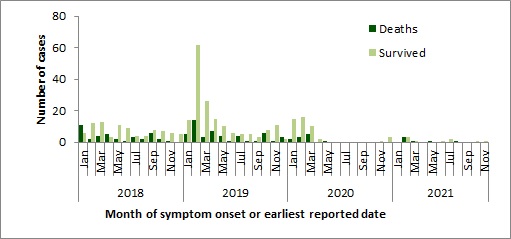
Note: Graph was prepared by the Centre for Immunization and Respiratory Infectious Diseases (CIRID) using data from the WHO Disease Outbreak News and Saudi Arabia's Ministry of Health. This graph reflects data available as of November 30, 2021.
Figure 4 - Text equivalent
| Date | Deaths | Survived | |
|---|---|---|---|
| 2018 | Jan | 11 | 6 |
| Feb | 2 | 12 | |
| Mar | 4 | 13 | |
| Apr | 5 | 3 | |
| May | 2 | 11 | |
| June | 1 | 9 | |
| July | 3 | 4 | |
| Aug | 2 | 4 | |
| Sep | 6 | 8 | |
| Oct | 2 | 7 | |
| Nov | 1 | 6 | |
| Dec | 0 | 5 | |
| 2019 | Jan | 5 | 14 |
| Feb | 14 | 62 | |
| Mar | 3 | 26 | |
| Apr | 7 | 15 | |
| May | 4 | 10 | |
| June | 1 | 6 | |
| July | 4 | 5 | |
| Aug | 1 | 5 | |
| Sep | 1 | 3 | |
| Oct | 6 | 8 | |
| Nov | 1 | 11 | |
| Dec | 3 | 2 | |
| 2020 | Jan | 2 | 15 |
| Feb | 3 | 16 | |
| Mar | 5 | 10 | |
| Apr | 0 | 2 | |
| May | 1 | 0 | |
| June | 0 | 0 | |
| July | 0 | 0 | |
| Aug | 0 | 0 | |
| Sep | 0 | 0 | |
| Oct | 0 | 0 | |
| Nov | 0 | 1 | |
| Dec | 0 | 3 | |
| 2021 | Jan | 0 | 0 |
| Feb | 3 | 3 | |
| Mar | 1 | 1 | |
| Apr | 0 | 0 | |
| May | 1 | 0 | |
| June | 0 | 1 | |
| July | 0 | 2 | |
| Aug | 1 | 0 | |
| Sep | 0 | 0 | |
| Oct | 0 | 1 | |
| Nov | 0 | 1 | |
- Footnote *
-
CFR: case fatality rate. Note that this rate is dependent on accurately reported deaths. For events with active cases, this value may be updated retrospectively as final disposition of the cases is known.
